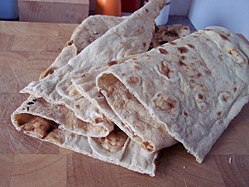 Taboon bread, main component of musakhan | |
| Type | Flatbread wrap |
|---|---|
| Place of origin | Middle East |
It has been suggested that this article be merged into Tandoor bread. (Discuss) Proposed since June 2025. |
Taboon bread (Arabic: خبز طابون, romanized: khubz ṭābūn) is Levantine flatbread baked in a taboon or tannur 'tandoor' clay oven, similar to the various tandoor breads found in many parts of Asia. It is used as a base or wrap in many cuisines, and eaten with different accompaniments.[1]
Variations
[edit]
Taboon bread is an important part of Palestinian cuisine,[2][3][4] traditionally baked on a bed of small hot stones in the taboon oven.[5] The hot stones give the bread an uneven texture and prevent the formation of bubbles in the bread due to the expanding water vapor, which facilitates adding toppings to it, but also prevents the formation of an inner hollow pocket like pita.[6][7] It is the base of musakhan, often considered the national dish of Palestine. Gustaf Dalman, a German orientalist, documented its making in Palestine in the early 20th-century, among other types of breads.[8] In Palestine, folded flat-bread was often filled with a spinach and onion mixture, or with cheese curds and onion mixture, or with raisins and pine nuts.[8] The ordinary taboon-bread was slightly smaller in size than the ordinary tannur-bread.[9] Over the centuries, bread-making in communal taboons played an important social role for women in Palestinian villages.[5]
See also
[edit]References
[edit]- ^ Skloot, Joe (February 28, 2002). "Falafel: Ambassador of peace or cuisine from mideast?". The Daily Princetonian. Archived from the original on 2009-08-19. Retrieved 2018-12-06.
- ^ Albala, K. (2011). Food Cultures of the World Encyclopedia. Greenwood. pp. 28–29. ISBN 978-0-313-37626-9. Retrieved 2019-10-03.
- ^ Whittemore, William Meynell (1874). Sunshine, conducted by W.M. Whittemore [and others]. p. 6 – via Internet Archive.
- ^ Albala, K. (2016). At the Table: Food and Family around the World: Food and Family around the World. ABC-CLIO. p. 171. ISBN 978-1-61069-738-5. Retrieved 2019-10-03.
- ^ a b "e-turathuna-Tabun - Bethlehem University". www.bethlehem.edu. Archived from the original on 2019-02-03. Retrieved 2019-02-03.
- ^ Kassis, Reem. "Taboon (Palestinian Flatbread)". Serious Eats. Retrieved 26 March 2025.
- ^ Tamimi, Sami; Wrigley, Tara. "8.1,7.1". Falastin A Cookbook. ISBN 9780399581748.
- ^ a b Dalman, Gustaf (1964). Arbeit und Sitte in Palästina (in German). Vol. 4 (Bread, oil and wine). Hildesheim. pp. 114–115. OCLC 312676221.
{{cite book}}: CS1 maint: location missing publisher (link) (reprinted from 1935 edition) - ^ Dalman, Gustaf (1964). Arbeit und Sitte in Palästina (in German). Vol. 4 (Bread, oil and wine). Hildesheim. OCLC 312676221.
{{cite book}}: CS1 maint: location missing publisher (link) (reprinted from 1935 edition), Diagram 30
